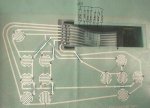#picaxe 18m2
;output 7 - FET to drive solenoid bolt
;output 6 - piezo sounder
;output 4,5 - bicolour LED
;output 3 - row 4
;output 2 - row 3
;output 1 - row 2
;output 0 - row 1
;input 0 - column 1
;input 1 - column 2
;input 2 - column 3
symbol key_pos = b0 ; number of keys pressed
symbol key_value = b1 ; value of key pressed
; *** reset position to zero ***
init:
let dirsB = 255
let key_pos = 0
; *** now scan each row in turn ***
; *** by setting only 1 row (and LED) high ***
; *** if a switch is hit jump call score sub below ***
;*********************lock close,enter code to open ***************
scan:
let key_value = 0
let pinsB = %00010001
gosub key_test
let key_value = 3
let pinsB = %00010010
gosub key_test
let key_value = 6
let pinsB = %00010100
gosub key_test
let key_value = 9
let pinsB = %00011000
gosub key_test
goto scan
; *** Score sub procedure. ***
; *** return straight away if no key pressed ***
key_test:
if pinC.0 = 1 then add1
if pinC.1 = 1 then add2
if pinC.2 = 1 then add3
return
; *** key value will already be 0, 3, 6, or 9 ***
; *** so add 1, 2 or 3 to this value ***
add3: let key_value = key_value + 1
add2: let key_value = key_value + 1
add1: let key_value = key_value + 1
; *** Make a beep ***
sound B.6,(60,50)
; *** Now increase position counter by 1 ***
; *** and test for 1st, 2nd 3rd or 4th push ***
let key_pos = key_pos + 1
if key_pos = 1 then test1
if key_pos = 2 then test2
if key_pos = 3 then test3
if key_pos = 4 then test4
; *** Now test the value for each position individually ***
; *** If value is wrong restart, if correct loop until ***
; *** fourth go. If fourth is correct open lock! ***
; *** Key code is set to 9-3-5-1 ***
test4:
if key_value = 1 then open
goto reset1
test3:
if key_value = 5 then continue
goto reset1
test2:
if key_value = 3 then continue
goto reset1
test1:
if key_value = 9 then continue
goto reset1
; *** Got here so open lock and set LED green ***
open: let pinsB = %10100000
'wait 5
goto init2
; *** Not correct value so reset position counter then return ***
reset1:
let key_pos = 0
; *** Okay so continue by returning back to main loop ***
continue:
return
'****************** lock open, enter code to close***********
init2:
let key_pos = 0
; *** now scan each row in turn ***
; *** by setting only 1 row (and LED) high ***
; *** if a switch is hit jump call score sub below ***
scan2:
let key_value = 0
let pinsB = %10100001
gosub key_test2
let key_value = 3
let pinsB = %10100010
gosub key_test2
let key_value = 6
let pinsB = %10100100
gosub key_test2
let key_value = 9
let pinsB = %10101000
gosub key_test2
goto scan2
; *** Score sub procedure. ***
; *** return straight away if no key pressed ***
key_test2:
if pinC.0 = 1 then add12
if pinC.1 = 1 then add22
if pinC.2 = 1 then add32
return
; *** key value will already be 0, 3, 6, or 9 ***
; *** so add 1, 2 or 3 to this value ***
add32: let key_value = key_value + 1
add22: let key_value = key_value + 1
add12: let key_value = key_value + 1
; *** Make a beep ***
sound B.6,(60,50)
; *** Now increase position counter by 1 ***
; *** and test for 1st, 2nd 3rd or 4th push ***
let key_pos = key_pos + 1
if key_pos = 1 then test12
if key_pos = 2 then test22
if key_pos = 3 then test32
if key_pos = 4 then test42
; *** Now test the value for each position individually ***
; *** If value is wrong restart, if correct loop until ***
; *** fourth go. If fourth is correct close lock! ***
; *** Key code is set to 9-3-5-1 ***
test42:
if key_value = 1 then close2
goto reset12
test32:
if key_value = 5 then continue2
goto reset12
test22:
if key_value = 3 then continue2
goto reset12
test12:
if key_value = 9 then continue2
goto reset12
; *** Got here so open lock and set LED red ***
close2: let pinsB = %00010000
'wait 5
goto init
; *** Not correct value so reset position counter then return ***
reset12:
let key_pos = 0
; *** Okay so continue by returning back to main loop ***
continue2:
return


